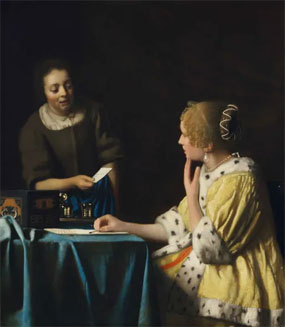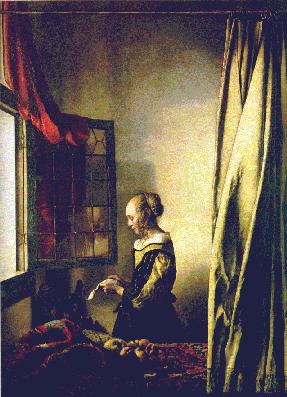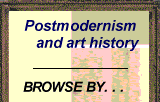Smart Painting
John Haberin New York City
Vermeer's Love Letters
You know the presumed evils of smart phones and the toll on young adults. They make it impossible to concentrate on books and chores. They drive teens to suicide.
But you have heard all that before, endlessly, whether it is true or not. You could call it a meme. Go easy, though, on the warnings—of bullying and peer pressure, fraught communications and awful isolation. They might apply tenfold to a woman reading a letter. They might have you looking again at a woman, her maid, and a love letter from Jan Vermeer. With "Vermeer's Love Letters," at the Frick Collection, you may wonder how painting itself communicates. 
The eye alone
To be sure, not every age is alike, and I lack credentials as social and technological commentator. Nor do I mean to distract from a favorite artist and a wonderful exhibition. I made a vow long ago to see every one of his roughly thirty-five paintings—and came seriously close after a 1996 Washington retrospective. Already by then I had written at some length about his Woman Reading a Letter in Dresden and how such modest means convey inner hopes, inner turmoil, a private space, and a larger world left unseen. The woman stands facing the window effectively looking out without once looking up.
Vermeer encompasses every variation in light—reflected off surfaces and in transit through the curtains. The woman's face itself reflects off panes of glass, seeming to dissolve into color before one's eyes. I asked how domestic objects become symbols and how narrative only enhances Vermeer's reputation for "pure painting." As I wrote then, something has entered along with the sunlight and letter, flung aside the small, red curtain above the window, and asked to enter even into her bed. Her downcast eyes direct a viewer's own into the painting and into her very being, just like the reflected light that points into the room. I continued in a review of his retrospective to map his career, optical command, and visual questioning—and a third review pursues Vermeer's women still further, through a Young Woman Seated at the Virginals.
Far be it from me to repeat all that. Rather than start over, I can only ask you to read my words from so many years ago. (Yes, this Web site has been around a long time and accumulated a lot of history.) Nor need I argue that letters could stir up pretty strong feelings—feelings about a woman and her lover. The very first novel in most accounts (and surely the dullest), Samuel Richardson's Pamela, unfolded entirely in letters, and it was not just a plot device. Needless to say, a painting or a novel about communication is also reflecting on itself.
Stick, then, to just three paintings and a single exhibition. If nothing else, it picks up the tale of the Frick's renovation and expansion from its April reopening. It opens a new gallery for nothing but temporary exhibitions, where the theater used to stand as a venue for lectures and music. The Frick need no longer set aside its holdings to make space for loans like, say, a past show of Dutch painting from the Mauritshuis—and a new, larger theater a floor below both looks and functions better as well. For now, three paintings hang side by side, with text on the wall facing the entrance. Each has its own partition, collectively spanning the gallery and masking the exit.
The museum, then, learns from Vermeer's talent for confined spaces. It includes a work from its own collection (the oldest in the show), in which one can all but measure the slim space beneath the woman's pen, its point resting on her table. She herself is measuring in her mind her distance from the letter that her maid holds out, tilted parallel to the pen—and her imagined distance from the outside world. Two more of Vermeer's paintings remain in their usual places in the Frick. Filling out the exhibition show are loans from Dublin's National Gallery and the Rijksmuseum in Amsterdam. It is a short walk to more Vermeer in European painting at the Met.
If the Frick's contribution to the exhibition seems the boldest in light and color, it has lost some of its shadow over the years. Those who know the artist will not be surprised that its black background was originally green. The background in the loan from Dublin is still green, while the loan from the Rijksmuseum places the woman almost in the background. One approach her across a dizzying pattern of floor tiles, with more barriers to either side. One approaches her, too, with the eye alone.
Except the light
Plainly Vermeer does not like to repeat himself. Any artist's studio is a confined space, with luck big enough for whatever is needed. And buyers often push for repetition, so that they know what to expect. This painter, though, makes each painting its own variant on a woman, a letter, and her maid. Each is a study in uncertainty, hopes, and fears. Each could belong to a larger story as well, without so much as the need for a maid.
Three paintings can take you only so far, even from someone with so small and so stunning an output as Vermeer. Think of them, though, as just three scenes in lives awakening to adulthood and to love. Women keep reading a letter over and over, like the woman at the window in Dresden, long after the servant who delivered it has gone. The man who sent it appears at last, the cape of a gallant or soldier fully framing her as she turns away, uncertain whether to take pleasure or to flee. He embodies a wider world that she cannot fully enter,  much like a map on the wall behind them both. He may have fought for the very city in Vermeer's light-filled view of Delft.
much like a map on the wall behind them both. He may have fought for the very city in Vermeer's light-filled view of Delft.
The three paintings on display put her through her paces. She prepares for the worst, hand to her chin, as the maid delivers the goods. She accepts the letter while still at her music, sign of love. She begins her reply. She bathes in sunlight from a visible stained-glass window. She lets the light define the interior, a woman's place, the window unseen.
She dresses as a lady, but she sits with a broom, a basket of dirty clothes, and a darker room to the side with a cabinet and linens. After all, she commands a wealthy household, but a woman's field of command includes cleaning house, and the maid is her intimate. She commands lavish pictures on the wall as well, including fertile Dutch landscapes that Vermeer would have known from his day job, as a dealer. The largest painting within a painting, The Finding of Moses, tells of an infant left to die in Egypt and his rescue by women. Who knows how far sexually Vermeer's woman has gone? Who knows, too, whether the fruit of love will lead the Jews or the Dutch to piety or to freedom?
Who knows anything for certain? As I wrote after his 1996 retrospective, I may believe in Vermeer's perfection, but I want to imagine his doubts—or are the doubts my own? The letter is often the brightest spot in a painting, but one cannot read a word of it. Nor can one quite read the women's faces. As the curator, Robert Fucci of the University of Amsterdam, argues, they always look away. Look again, though, and they are questioning, smiling, angry, or close to tears.
Look again, too, at the woman already intent on writing, a draft crumpled on the floor. Maybe the soldier's letter angered her, and she rushed to begin a more disillusioned reply. Or maybe she thought that she would never hear from him again, only to begin a more hopeful letter before it was too late. Whatever the truth, Vermeer creates the space of a woman's world. He trusts to an economy of vision that for many a modern viewer nears abstraction. He leaves everything uncertain except for the light.
A postscript: another lover
Siri Hustvedt practices an impressionistic style of art history. In her 2007 paperback, Mysteries of the Rectangle, she plays the amateur, finding deep meanings in painting that mere scholars overlook. The practice has long gone out of fashion, except on televised series. It resembles Robert Hughes without his massive ego and derogation of art—or Simon Schama without the imaginative leaps and erudition. It can, however, still be entertaining.
In Hustvedt's case, it is, but the amateur stance can also be infuriating. She spends some time on the mystery of Giorgione and The Tempest, starting as ever with her own surprise and concluding with surprisingly little. She had never anticipated the painting's small size and the resulting intimacy. She had forgotten the man at left. Contemplating the work's mysterious subject matter for a chapter, she concludes simply that one may never know, and the painter probably intended it that way.
The writer's foregrounding of the writer rather than artist, however, has a sophisticated point as well. Hustvedt's theme is the rectangle, the painting's frame. Peering through it makes an encounter with the work a kind of voyeurism, and from there it is only a short step to acknowledging the very private wishes of Giorgione's patron. Imagine the same act of regard in the man's distant gaze and the woman's naked body, although—or perhaps because—they will never meet.
This is pleasant and safely postmodern but not too provocative criticism. One accepts that it restores the old metaphor of a painting as a window onto reality or the imagination. One gets the joke about the male gaze without having to sound feminist in confronting the male aesthete. One accepts the frame as an absolute division and not, as Jacques Derrida argued, a place both in the work and the world able to unsettle both. One does not have to pursue Derrida's idea to further disjunctions with the painting either.
For another example, Hustvedt turns to the most careful observer of all, Vermeer, with his woman raising her pearls toward the window. Hustvedt does not compare her window to the real frame. She plays the clumsy sleuth again, comparing her to Mary's acceptance of God's radiance in an Annunciation. He stumbles one by one upon similar motifs in the Italian Renaissance, as if it did not define the whole subject. Finally, a chance discovery at the Met makes it all clear, thanks to a work by Jan van Eyck or Petrus Christus.
And that is why I mention the book. Years ago here, when this brief postscript first appeared, I compared Vermeer's women to van Eyck's Madonna in a Church. I asked to see this as part of how Vermeer conveys light as both medium and meaning, the woman as private and longing for the world, her sexuality as pure and impure, and the painting as time bound and an object of contemplation. I do not claim it as much more than a truism, but I got there first.

"Vermeer's Love Letters" ran at The Frick Collection through August 31, 2025. Mysteries of the Rectangle, by Siri Hustvedt, was first published in hardcover in 2006 by Princeton Architectural Press. The Web can point you to All About Johannes Vermeer, including what little is known of his life, and to a guided tour of his Delft.




